Groin Muscle Injuries – How, why, & the function test
| April 9, 2014 | Posted by Melinda under Vet & Sports Medicine |
This is the third post in the series about groin muscles, based on a seminar at the AERC convention presented by Dr. Marcello.
When we were looking at the specific muscles of the “groin group” and I mentioned that most of the injuries occurred in the tendon portion of the muscle – tendons connect muscle to bone and ligaments connect bone to bone. A tendon can take many different “shapes” (ropes, sheets) but in general a tendon is fibrous connective tissue that connects the hardworking red stuff to the dense hard white thing. I’m not saying that tears in the muscle (red stuff) CAN’T happen, especially in an acute traumatic injury, but that may be one reason it’s hard to see and diagnose the more minor groin injuries. Unlike legs that show filling and inflammation readily, the big ‘ole group of muscles on the inside of the leg are already a bit amorphous. Not to mention if the horse really is feeling a lot of pain when you palpate the area, you are near the powerful kicky part of the horse. 🙂
If it’s minor and hard to find do we still care? YES. From human data we know that even minor groin injuries are hard to rehabilitate. In fact, veteran hockey players have 5x groin injury rate than rookies – perhaps suggesting that if you are doing sports prone to these injuries, perhaps accumulate over time, and are difficult to completely heal?
Groin injuries are divided up into classes (I, II, III). Classes are assigned based on the amount of pain the (human) patient is experiencing, and what they can see on various diagnostics.
Grade 1: mild discomfort. For humans this means “when I step off it hurts, but then I push and it doesn’t hurt”. In our horses, this means that there is often no lameness associated with this class of injury. There may or may not have a tight or tense muscle in that group of muscles that we discussed in an earlier post. Grade 1 injuries are hard to find. For both the rider AND the vet it is important NOT turn a mild grade 1 into something worse. It’s hard to see, it’s hard to diagnose – but you haven’t done your horse any favors if you make it worse and turn it into a grade 2 or 3!!!
Grade 2: sharp pain/discomfort in inner thigh. It often takes 12-24 hours for tightening and swelling to show up. In our horses this means that they could look fine immediately post ride, but show up with an injury some time in the day after the ride. Horses look normal at the walk, lame at the trot and usually bring their hind leg closer to midline during the trot to try and minimize strain on that inner thigh group of muscles.
Grade 3: Noticeable/severe pain on occurence. This can manifest with sudden lameness after a fall or other trauma. Usually we can actually see a hematoma or fluid on the ultrasound.
If it’s a low level injury you are looking at rest, surpass. If acute enough, cold therapy, laser, NSAIDs – sound familiar? Turns out a tendon is a tendon no matter where it is on the body (and recovery times in the tendon/muscle unit are similar to tendon injury healing in the leg – MONTHS). Low level groin injuries show significant improvement, but it is prone to re-injury. In the case example Dr. Marcello presented of a low level injury, the horse was good enough to go back to work (dressage horse) and was considered sound, but you could still see a slight something if you knew where to look. If a grade 1 can be so difficult to treat, you can imagine that as the injuries get more severe, the likelihood of the horse returning to previous performance levels decreases. 🙁
How?
Besides acute trauma from a fall or a stupid pasture antic, there are other ways we can overstress the groin muscles over time and cause injury……Here’s a couple of endurance specific ones that Dr. Marcello mentioned in his presentation.
- exercise on uneven terrain for a long period of time in one direction
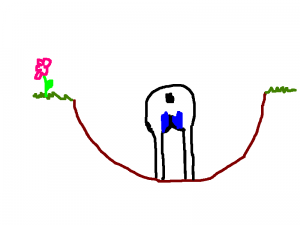
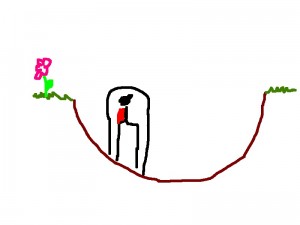 Lameness compensation (sorry, there aren’t cute cartoons for all of these – use your imagination)
Lameness compensation (sorry, there aren’t cute cartoons for all of these – use your imagination)- rider imbalanced, rider injuries, poor riding
- uneven foot care
- Poor saddle fit
- other tack influences (bit etc.), balance of saddle bags
- Fitness of Rider (lose weight, exercise, be fitter!)
Why?
Turns out that the way that both the hind legs of horses move and the way ice hockey players skate (inside toe, slight outside push) creates forward pulpulsion, hip movement, and works the abductors and adductors (outside and inside muscles of the thigh) unequally. In humans, this unequal work (and strength gain) increases the risk of groin injury.
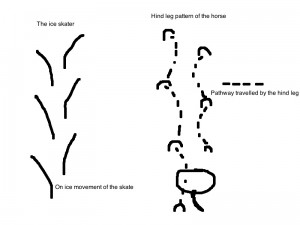 Besides minimizing all those factors listed above that overstress the groin, can we minimize this risk by conditioning our horses in a certain way?
Besides minimizing all those factors listed above that overstress the groin, can we minimize this risk by conditioning our horses in a certain way?
YES!!!!!
Back to the human statistics, it turns out that STRETCHING makes no difference. Stretching does not PREVENT or TREAT groin injuries.
Pre-season strength DOES matter.
Working the horse in “straight forward” work works the adductor/abductor unevenly. To even out the strength gains (in the muscle groups on the inside and outside of the thigh) you can add:
- Lateral work
- Elevation work (An example of this is working on one side of the banked trail in the cartoon where it’s not level. Make sure you work both sides!)
- Incline lunging (Lunge on the side of a hill. Make sure you do this going both directions)
- Serpentines
This work needs to be kept SHORT. Don’t do this when you are planning on going out on a long ride. Don’t do it when the horse is already fatigued. Don’t do it until your horse’s muscles are trembling from exhaustion. 10-15 minutes of focused work and then quit. This sort of work is perfect to do when you don’t have a lot of time! Very soon we will talk about the mTOR pathway and why, if you are trying to build muscle, you should separate your muscle building exercises from your longer endurance training. Consider doing this sort of work separate from your regular long training days.
Diagnosing
Injuries can be acute and traumatic, or they can be more chronic injuries of the muscle tendon unit. Depending on the “grade” the injury could be more or less obvious and ultrasound may or may not show anything. The horse may or may not be lame. Maybe he’s just not moving “quite right”. Dr. Marcello said that most cases had vague complaints in specific circumstances – they aren’t always lame! If you don’t have a thermography camera (totally coveting this little gadget by the way…..) there’s a way to see whether there is an underlying groin muscle issue behind the “NQR”. Dr. Marcello called it “the function test”.
The idea behind the function test of the groin muscles is to isolate those muscles and see if they can perform normally without pain. Dr. Marcello had videos to show this “function test” and I would be more than happy to show you what it looks like in real life if you catch me at a ride. However, in this blog I’m going to show you the theory behind test and explain why it works.
Let’s return to our nicely colored diagram that shows off the muscles we want to isolate and test whether they are functioning normally.
The first step is to take the opposite hind leg out of the equation. In my diagram I used my handy eraser to erase the lower right hind leg. In real life you would pick this leg up at a level that is comfortable to the horse – this isn’t a flexion test, you aren’t pulling it – you are just trying to remove it from the ground so that the horse can’t use it to stabilize itself and has to use the left hind.
Imagine if you are holding the left hind leg in a neutral position off the ground and you reach up with one hand and push on the hip away from you (represented by the black arrow). The horse’s balance is going to shift towards the left, and to counteract the pressure on the left hind, the muscles on the OUTSIDE of the thigh are activated to help maintain balance.
To activate the muscles of the INNER thigh (groin) the horse needs to be pushed off balance TOWARDS the side you are holding the leg. How can you accomplish this.
While it is true that you could have someone else on the opposite side pushing the hip towards you – this is unnecessary (and probably unsafe, not to mention as a vet you don’t always have a assistant, AND since this test will be repeated on both legs to compare the response I want to make sure that the pressure is applied the same way with the same force, so I want to be able to do the entire test myself to reduce variability).
You can use the horse’s TAIL to move the pelvis towards the hind leg that is lifted. The tail is passed under the point of the hock, and without pulling the leg outward, the tail is pulled to apply pressure that shifts the horse’s balance towards the right, and engages the muscles on the inner thigh of the opposite leg (the groin).
Depending on how the horse responds, this “function” test can help isolate whether the groin muscles are a source of discomfort.
These were the main points presented about the groin. Any questions? There was some discussion on the pectoral region injuries – however there wasn’t a lot of data, the test is less straight forward, and I didn’t find the presentation as convincing, which is why we focused on the groin muscles here. (80% of the seminar was on the groin during the convention).
Michael Beesley’s book “Equine Performance Therapeutics” was highly recommended and Dr. Marcello worked closely with Beesley before he passed away recently. I was not able to find a good source on the internet for the book, but would be HIGHLY interested if anyone was able to find a source……….


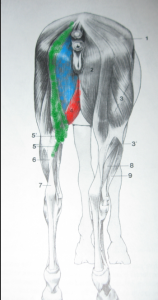
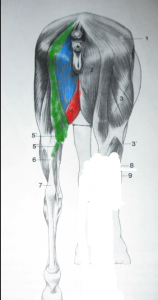
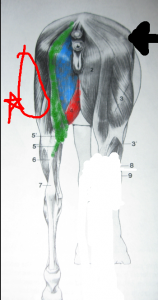
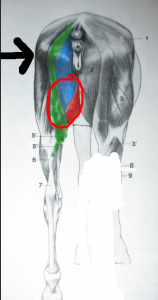
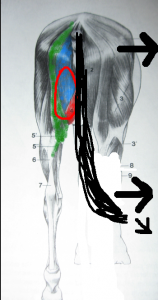








Would an inner groin pull also be indicated by the turning in of the toe of the affected leg as that leg is being used in forward motion? I have a 34 yr old senior that got caught in his blanket getting up, seemed to affect his right leg. As he used the right, the toe would turn in and he’d place the leg more under him than normal. I ask about the groin because massage and PEMF to that region seemed to alleviate the pain over time.
The only other time I’ve seen that gait movement was a mare after delivering a very large foal. She also showed improvement when treatment was applied here. Thanks, just trying to put the pieces together.
It’s hard because the groin is a really complicated area anatomically to say definitely over the internet. It’s possible. Since writing this post a lot of years ago, I personally pulled a groin muscle and I have to say it was one of the most painful injuries that I’ve ever had,. It was AWFUL and definitely affected my foot placement as I tried to avoid loading that muscle.
My horse was sore on palpitation in the left groin from the vet. I’m meant to do 6 weeks walk and trot he doesn’t appear lame at the trot but rests the leg throughout the day after. Should I reduce trot time to just walking?
Unfortunately I’m unable to give individual vet advice remotely. Please follow up with your local vet 🙂
Great article. So if it determined that your horse has a groin injury and the ct scan shows a thickening of the inner thigh muscle, and the horse is only lame at the trot, what is the treatment. My vet had been trying to treat her for the past year. Nothing has helped. Anti inflammatories and rest had no positive results.
I’m not sure. I’d probably try and get an evaluation with a sports medicine specialist veterinarian and see if there is some specific rehab/PT and ultrasound therapy.
Hi not sure if you still see these comments but you don’t actually explain the expected (or not) results of the function test- and therefore what they mean. What response are you looking for to show how each muscle is responding ?
Yep I do review comments still :). In general when those muscles are loaded and they don’t want to be because the horse experiences pain when landing them, the horse responds to this test by staggering/bending/wiggling/swaying or otherwise finding any excuse or way NOT to engage the muscles of the inner thigh. Comparing the response of the two sides is helpful. Does this help? If not I can try and find a way to explain that uses more words, but I also know that I have a tendency to use a lot of words when I don’t need to ?. It’s been a while since I wrote this post obviously, and it’s funny, I think it totally escaped me that I didn’t describe what I saw in those videos at that conference. And you are the first person that has asked! Thanks :). Note that this function test evaluates the muscle groups as a whole and it’s usually not possible to tell the exact muscle in the “groin muscle” that is feeling ouchy. Palpation can sometimes isolate it.
Since writing this post I personally had a groin injury and BOY HOWDY I can attest how sore these injuries are and how hard they are to rehab. The other interesting thing was until I moved or loaded my leg in a certain way to load the groin, I was perfectly fine, but when I stepped a certain way it was so painful I wanted to crumple to the ground – just like when a horse looks ok until we get that muscle group to fire and work and then we can see just how painful it is.
I’m very much a lay person and my gelding is the yard ornament I swore he would not become! But your information here has helped me determine his issue is likely not the stifle at all but a “groin” issue. Thank you so much for the time and care taken to convey the information.
Thank you for that. It’s helped me diagnose a difficult hind leg lameness. The groin muscles is attached to so many upper back muscles and my horse had put it all out. By the time I arrived home which was five weeks after the injury, he had shortened his back, put his sacro-illiac joint out and was throwing his leg out as he walked. I managed to sort out back, joint and resulting leg swelling but he was still lame. I then felt the inside of his leg and it was swollen with veins that stood out. I relaxed it a bit but still lame. I can only assume the problem is strain within that area. He is booked in for a lameness test next week. I have been a chiropractor for over 20 years and this is the first time an injury had such a knock on effect. Thank you again. I feel quite happy with my diagnoses. Anne Main
Great write-up – do you have anything on tail holding patterns? I am an equine bodyworker and have a client that suddenly holds his tail to one side and I can’t find anything helpful about the matter…
No I don’t – Most of the time it seems to be an ingrained preference – but a sudden change is always worrisome.
thank you for writing up these great (and useful) reports from the front
Fascinating! Thank you so much for writing all this up!